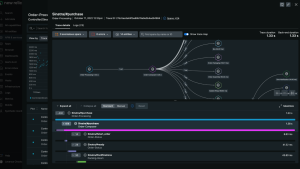To learn more about New Relic customers like DeltaBlue, explore their stories at Our Customers.
At DeltaBlue, a platform-as-a-service (PaaS) platform designed to increase time to market by automating application lifecycle management, we take an approach unlike many other providers in our space: We are virtualization-agnostic. This allows us to support containers as well as full VMs and bare metal. Rather than just running on top of Kubernetes, you can run Kubernetes on top of our platform.
Our platform is fully API-driven, but it also has a well-designed drag-and-drop style web interface. With the UI, you can treat an application like a black box with configuration management, network infrastructure, application cloning, and snapshots, extracted from the application but integrated into the portal.

We also integrate with a number of partner vendors. For example, through our integration with Dutch AIOps startup Vamp, we support canary releases, or gradual releases for any web-based application. This means that different versions in production can be linked to different branches within your Git repository, and based on business KPIs, you can present them to different targeted end users. Now you can put a new version of your internet shopping site live just for customers in a particular country or region, such Belgium or Europe, and then monitor for impact on areas, such as CPU utilization, average response time, HTTP error rate, conversion rate, and so on. You can then gradually increase the amount of traffic you send to the new version of the site either manually with a simple UI slider ,or automatically, using a variety of different data sources.
For the data sources available to automate this process, you can use standard web analytics data such as page load time. We also integrate with both Glasnostic and New Relic.

The Glasnostic integration gives us insights into what is happening in the infrastructure layer, allowing us to make predictions about network utilization, for example. This means that a customer would be able to throttle network traffic to keep an application up and running if they are reaching a limit that they can’t quickly scale past, such as an Oracle licensing limit. But it also gives insight into changes in network load to databases or other external services.
A holistic approach
With the New Relic integration, we can look at telemetry data such as application response time and database load at the backend—and even frontend data such as asynchronous scrolls—to give us a real sense of a user's perception of how a site is performing. This type of information is crucial in making value decisions, such as, “Is the new site faster or better-performing because there are just a few customers on it compared with the old version? Or, is it really better performing?” It also gives us the ability to make better educated guesses regarding capacity management, how much and how different the new load is from a database perspective, and when it will max out.
This same data can be used to control the amount of traffic flowing to a particular version of a website. Imagine deploying a new version. If it is producing better rates of customer conversion and all the backend signals still look OK, our platform can gradually and seamlessly ramp up traffic to the new site until all your customers are served by the new version. Conversely, if the new site isn’t performing as well as expected, it can easily be rolled back using the same mechanism. But you can ramp down traffic to the new site, all without negatively affecting the customer experience.
Our approach to our New Relic integration
A key goal for us is to make our platform as easy to use as possible, so the only option for us was to have complete integration with New Relic. As an example of what that means in practice: If you are a DeltaBlue customer with an existing New Relic One account, we can simply reuse your existing account. Conversely, if you do not already have a New Relic account, we automatically create one for you through the DeltaBlue portal, allowing you to manage both your DeltaBlue and New Relic accounts in one place. We will also handle the financial side of things, adding a line item in the invoice for the New Relic amount. “No hassle and a single point of contact” is our motto.
Within our platform, we reuse many New Relic One features, so what you see within the DeltaBlue platform resembles what you would see in New Relic One. We have come up with a default dashboard for common languages and applications including PHP and Java, as well as for e-commerce tools such as Shopware or PrestaShop. If the default features are insufficient, we can also quickly add custom widgets to these dashboards as required—and we will be adding more features to them over time.

Lessons learned from our integration with New Relic
The approach we took for our New Relic integration was, we think, new to both companies. We found, however, that in practice it was fairly straightforward, taking us only a single three-week sprint to get the basic integration done, with a second sprint to finalize it all and put it into production. This made it a fairly short project, with what we believe to be huge added value for our customers.
In practice, the biggest hurdle we faced wasn’t a technical challenge, but was around differences between our respective SLAs. We now see that customers are using this functionality more and more often, we even have a number of customers choosing for DeltaBlue because of this built-in feature. The real value is that they can answer and debug any kind of performance-related problem from one place, with no need for extra knowledge or resources.
At New Relic, we're constantly developing our strategies and platforms. See how building fintech consumer consent workflows is a part of our strategy.
Nächste Schritte
Check out developer.newrelic.com to learn more about custom integrations. We recommend our Infrastructure monitoring integration to get you started.
Die in diesem Blog geäußerten Ansichten sind die des Autors und spiegeln nicht unbedingt die Ansichten von New Relic wider. Alle vom Autor angebotenen Lösungen sind umgebungsspezifisch und nicht Teil der kommerziellen Lösungen oder des Supports von New Relic. Bitte besuchen Sie uns exklusiv im Explorers Hub (discuss.newrelic.com) für Fragen und Unterstützung zu diesem Blogbeitrag. Dieser Blog kann Links zu Inhalten auf Websites Dritter enthalten. Durch die Bereitstellung solcher Links übernimmt, garantiert, genehmigt oder billigt New Relic die auf diesen Websites verfügbaren Informationen, Ansichten oder Produkte nicht.



